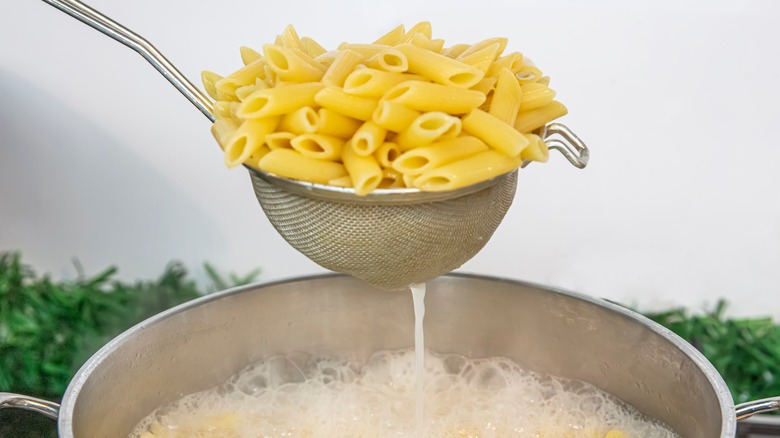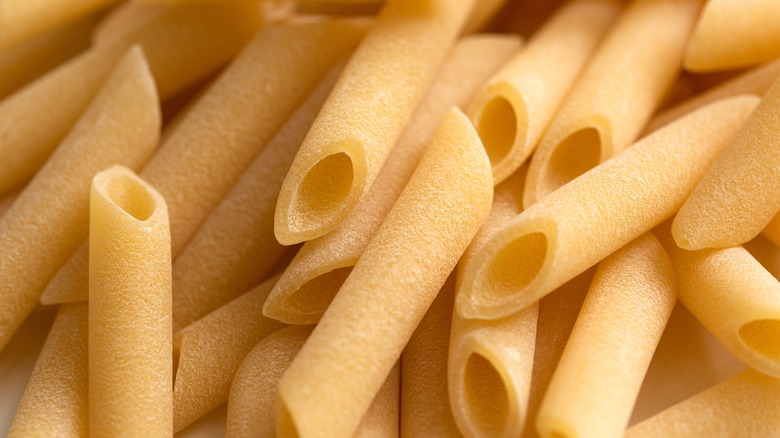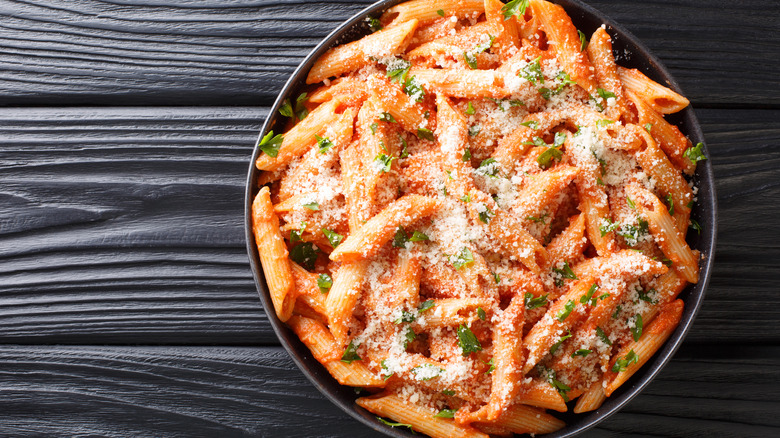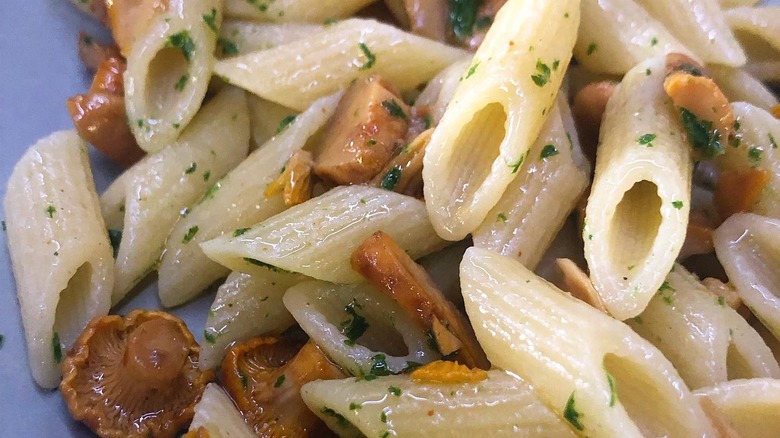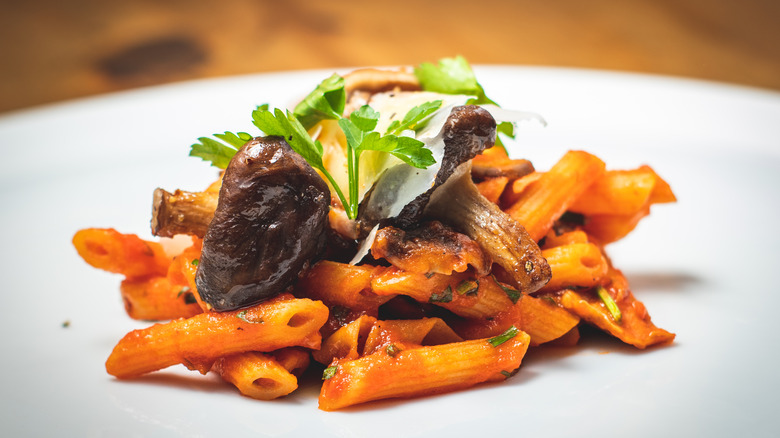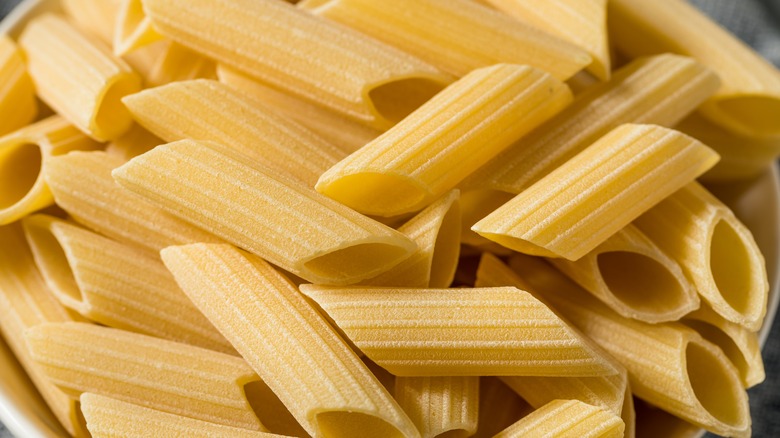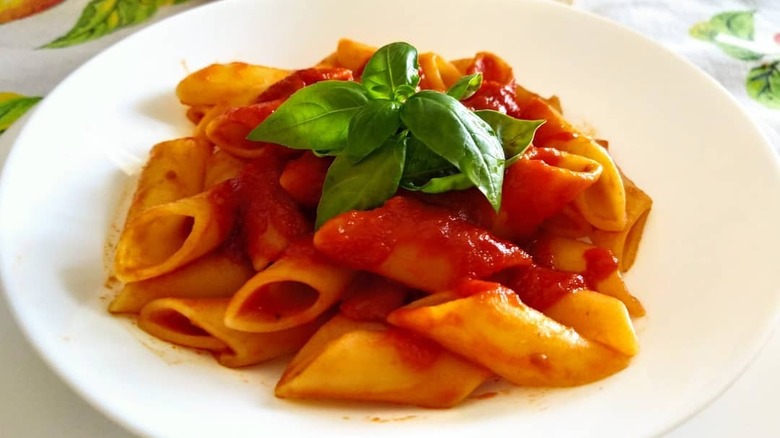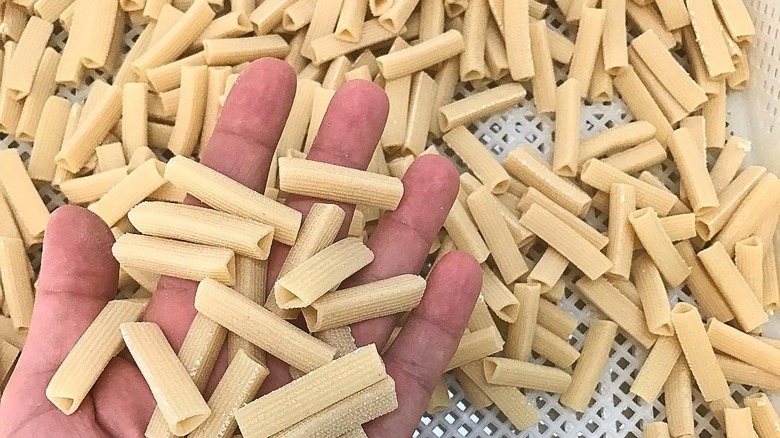Penne Pasta Comes In More Sizes Than You Might Expect
It's hard to quantify the many different types of pasta. You might've seen the number 350 thrown around, but experts can't agree. Given that there are so many varieties of pasta, it shouldn't come as a surprise that many of the most popular types have a host of subcategories. Penne, one of the best-selling types of pasta in the world, is no exception.
Penne is a tubular pasta with pointed ends. It was invented in 1865 when Giovanni Battista Capurro created a machine to cut the ends of pasta at a diagonal. The ends, which look like the nib of a quill or fountain pen, give the pasta its name: "Penne" is Italian for "pen." Penne pasta tends to work well with thick sauces or vegetable dishes since the tubular shape helps collect morsels of meat and vegetable and makes them easy to collect on a fork.
Pasta pairings are a serious business in Italy, and many popular dishes are traditionally made with penne. Roman classic penne all'arrabbiata pairs the pasta with spicy red sauce. In Tuscany, it's doused in cream for penne alla fiesolana. In Florence, penne strascicate is served with a hearty ragu.
In America, you might find penne as a substitute for elbow macaroni in mac and cheese, doused in Cajun chicken sauce, or incorporated into American riffs off Italian cuisine like penne alla vodka. But, whether you're cooking traditional Italian cuisine or American classics, consider the type of penne you're using. Even subtle differences can have a big impact.
Penne lisce
Penne lisce, or "smooth" penne, goes by many names. Throughout Italy it's known as spole, maltagliati, or attuppateddi — in America, the style is sometimes called mostaccioli.
When most people think of penne, they think of penne rigate, or "ridged" penne, which features fluted ridges meant to grip pasta sauce. As the most popular style, penne rigate is often seen as the default, favored over penne lisce. When the Covid-19 coronavirus pandemic first sent Italy into lockdown, viral images showed supermarket shelves stripped bare of pasta — save for boxes of penne lisce.
However, penne lisce has the distinction of being the "original" penne style. It's still popular in some regions of Italy, and it isn't necessarily as slippery as penne rigate fans think. Professor Alberto De Bernardi, who wrote a book on the social history of pasta, told Quartz that high-quality penne lisce made to traditional standards should have a slightly rough, porous surface, the perfect vehicle for sauce. Ridges, which came about when companies began mass-producing pasta after World War II, were originally used to disguise a lower-quality product.
If you want to try penne lisce, look for high-quality bronze-drawn pasta made using traditional methods. It's most popular in the Campania Region of Southern Italy, so it's a good option for dishes from Naples or Capri. It's also used in American dishes like baked mostaccioli. Like the ridged version, it's typically paired with red sauces, used in pasta salads and baked dishes, or eaten with hearty meats.
Penne rigate
While penne rigate may have originated as a way to disguise a cheaper product, the style has turned into something more. The ridged pasta has become a tradition in Northern regions of Italy, like Lombardy, earning a place in the hearts of Italians and foreign pasta fans alike. Some people like the texture that the ridges provide. It's no longer relegated to cheap, mass-produced products, either. Since the ridged style has become the norm, high-quality pasta brands typically make penne rigate in addition to traditional offerings.
Professional chefs may prefer penne lisce, but penne rigate is a great option for home cooks. If you want an inexpensive pasta that works well with sauce for a regular weeknight meal, penne rigate will outperform your standard supermarket penne lisce. Watch out, though — it's easy to overcook penne rigate. Since the ridges cook faster than the rest of the pasta, the outside can get mushy if you're not careful.
Mezze penne
While the diameter is roughly the same, mezze penne, or "half" penne, is a shorter version of the classic penne pasta. Like most penne variations, it comes in both ridged and smooth varieties.
When you're deciding how to use mezze penne, keep the standard rules in mind: Pasta is supposed to be roughly the same size as the meats or vegetables that you're using, so use mezze penne in dishes that would be overwhelmed by full-sized penne. Smaller pasta tends to go well with lighter sauces, in pasta salads, or incorporated into soups, too.
Pennette
You might be able to guess from the name: Pennette is miniature penne. While mezze penne cuts standard-size penne in half, pennette pasta has a small diameter than regular penne — though it's sometimes proportionally longer. You can buy pennette with ridges or opt for the style known as penne ziti, a smooth-sided favorite from Southern Italy.
Pennette still has its uses, though: Since the shape fits comfortably in a spoon, it's well-suited for soups, light sauces, and pasta salads. Avoid using it in dishes that incorporate big chunks of meat or vegetables that could overwhelm the dainty pasta.
Pennoni
In contrast to dainty pennette, pennoni pasta is the giant of the penne world. After all, "pennoni" translates to "large quills." Pennoni pasta is bigger and thicker than standard penne, though it's typically used in a similar way. The shape is sold in both ridged and smooth varieties.
While there's debate on the origins of pennoni — it's popular throughout Italy — it likely originated in the Veneto region. Pennoni is large enough to stuff with fillings like ricotta cheese, but it also works well baked into casseroles. The pasta is big enough that it won't be overwhelmed by large pieces of meat or vegetables, so don't be afraid to serve it with thick, chunky sauces. You can honor its Venitian heritage by pairing it with seafood, but the pasta is used in popular dishes from other regions, too. It works well in pasta alla pizzaiola, a Neopolitan dish traditionally made from leftover pizza sauce, or pasta alla norma, a Sicilian classic featuring eggplant, tomato, and ricotta.
Penne a candele
The name penne a candele references a type of pasta known as "candele," or "candles." Long and tubular — think spaghetti crossed with ziti — candele pasta is a traditional style thought to be named after the taper candles used in religious processions. Like its namesake, penne a candele is a thick, substantial pasta, which hails from Southern Italy. It's always smooth and has a firm bite. While candele is traditionally broken into pieces, penne a candele comes pre-cut into the classic penne shape. It can be bigger and thicker than standard candele, too.
Penne a candele is often used in hearty oven-baked dishes. If you want to stay true to the pasta's Southern roots, pair it with traditional Neopolitan sauces — but don't be afraid to add capers, spicy sausages, and plenty of garlic. The pasta's substantial size means that it pairs well with intense flavors that would overwhelm smaller shapes.
Trenne
A mash-up of "triangle" and "penne," trenne pasta is — you guessed it — triangular-shaped penne. The unique and somewhat obscure variety features three sharp angles to complement its pointy ends, giving it a "futuristic" appearance.
Its unusual shape might seem like a gimmick, but chefs praise trenne for its unique features. The flat sides make it easy to sauté cooked pasta in a frying pan for an unexpected crunch and a light toasted flavor. It's a good choice for baked dishes, too, and looks attractive on a plate thanks to the way that the angular sides stack together.
Trenne is a modern style, designed by pasta brand Rustichella d'Abruzzo. It's become popular enough that other brands have started selling it, but you probably won't be able to find it in your standard American grocery store. If you're interested in trying trenne yourself, you might have luck at a specialty food store — but most likely, you'll have to order it online.
